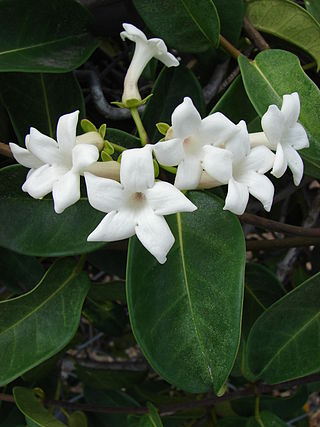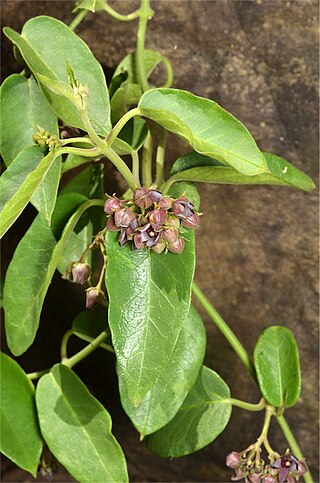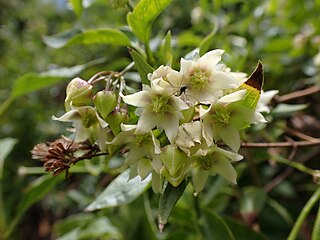
The Asclepiadoideae are a subfamily of plants in the family Apocynaceae. Formerly, they were treated as a separate family under the name Asclepiadaceae, e.g. by APG II, and known as the milkweed family.

Cynanchum is a genus of about 300 species including some swallowworts, belonging to the family Apocynaceae. The taxon name comes from Greek kynos and anchein, hence the common name for several species is dog-strangling vine. Most species are non-succulent climbers or twiners. There is some evidence of toxicity.

Stephanotis is a genus of flowering plants first described in 1806. The name derives from the Greek stephanōtís fit for a crown, derivative of stéphanos (masculine) crown. It contains evergreen, woody-stemmed lianas with a scattered distribution in several tropical and subtropical regions.

Vincetoxicum rossicum is a flowering plant in the family Apocynaceae. It is a perennial herb native to southern Europe and is a highly invasive plant growing in all of the Eastern United States, in the mid west, and southern Ontario and Quebec in Canada. It has several common names including swallowwort, pale swallowwort, and dog-strangling vine; though it does not actually strangle dogs, it can “strangle” native plants and small trees if it is in dense patches. There has historically been much confusion about the genus it belongs to, with authors placing it within Vincetoxicum and others within Cynanchum, but recent molecular and chemical analyses have shown it to belong in the genus Vincetoxicum.
Vincetoxicum tsaii is a species of plant in the family Apocynaceae first described in 1941. It is endemic to Yunnan Province in China.
Vincetoxicum shaanxiense is a species of plant in the family Apocynaceae, first described in 1905. It is endemic to China, known from Gansu and Shaanxi Provinces.

Marsdenia is a genus of plants in the family Apocynaceae first described as a genus in 1810. It is named in honor of the plant collector and Secretary of the Admiralty, William Marsden. The plants are native to tropical regions in Asia, Africa, Australia, and the Americas.
Tylophora is a former genus of climbing plants or vines, first described as a genus in 1810. The genus was originally erected by Robert Brown for four species he described in Australia. It was synonymized with Vincetoxicum in 2018, a decision accepted by Plants of the World Online as of February 2023.

Vincetoxicum is a genus of plants in the family Apocynaceae. Although the species in Vincetoxicum have sometimes been included in Cynanchum, chemical and molecular evidence shows that Vincetoxicum is more closely related to Tylophora, now included in Vincetoxicum. The generic name means "poison-beater" in Botanical Latin because of the plants' supposed antidotal effects against snakebite.

Vincetoxicum barbatum, synonym Tylophora barbata, the bearded tylophora, is a small vine in the dogbane family. A common plant found south of Bulahdelah, New South Wales. The habitat is rainforest and moist eucalyptus forests in south eastern Australia. Not often seen in flower, but flowers are dark red, around 7 mm long on thin stalks. Broken branches produce watery or milky sap.

Vincetoxicum polyanthum, commonly known as coast tylophora, is a vine in the dogbane family Apocynaceae first described in 1891 by the German botanist Otto Kuntze. It is native to the Australian states of New South Wales, the Northern Territory, and Queensland. In the Australian Tropical Rainforest Plants identification key, it is still treated as Tylophora benthamii.

Jobinia is a genus of flowering plants of the family Apocynaceae first described in 1885. It is native to South America and Central America.
Vincetoxicum hainanense is a species of plants in the Apocynaceae. It was first described in 1941 as Merrillanthus hainanensis, which was the only species in the genus Merrillanthus.
Vincetoxicum oblongum is a species of plants in the family Apocynaceae, native from west tropical Africa to south-west Ethiopia. Its synonyms include Oncostemma cuspidatum, at one time placed as the only species in the genus Oncostemma.
Vincetoxicum lineare is a species of plant in the family Apocynaceae native to Australia. Known as the bush bean, it is an edible species of plant found in arid regions. As Rhyncharrhena linearis, the species was at one time the only species in the monotypic genus Rhyncharrhena.
Vincetoxicum rupicola is a species of plant in the dogbane family Apocynaceae that is endemic to Queensland, Australia. It was first described by Paul Irwin Forster in 1992 as Tylophora rupicola.
Vincetoxicum forsteri is a species of plant in the dogbane family Apocynaceaethat is endemic to Australia. It was first described by Paul Irwin Forster in 1992 as Tylophora linearis.
Vincetoxicum cameroonicum is a species of flowering plant in the family Apocynaceae, native from Benin to Uganda in tropical Africa. It was first described by N. E. Brown in 1895 as Tylophora cameroonica.
Vincetoxicum anomalum is a species of flowering plant in the family Apocynaceae, native to the island of Bioko and Cameroon in the west of Africa, and from Uganda to KwaZulu-Natal and the island of Mayotte in the east of Africa. It was first described by N. E. Brown in 1908 as Tylophora anomala.









